Abstract
Enhanced nitric oxide (NO) generation by stimulated NO synthase (NOS) activity may, through its oxidative metabolism contribute to tissue injury in experimental colitis. In this study the possible amelioration of experimental colitis by NG-nitro-L-arginine methyl ester (L-NAME), an inhibitor of NOS activity, was evaluated. Colitis was induced in rats by intracolonic administration of 30 mg trinitrobenzene sulphonic acid (TNB) dissolved in 0.25 ml 50% ethanol or by flushing the colon of capsaicin pretreated rats with 2 ml of 5% acetic acid. In several experiments, L-NAME 0.1 mg/ml was added to the drinking water at the time of colitis induction with TNB or seven days before acetic acid treatment. Rats were killed at various time intervals after induction of colitis. A 10 cm distal colonic segment was isolated, weighed, lesion area measured, and explants organ cultured for 24 hours for determination of NO generation by the Greiss reaction. The rest of the mucosa was scraped for determination of myeloperoxidase and NOS activities and leukotriene generation. In TNB treated rats mean arterial pressure was also determined up to 72 hours after damage induction, with or without cotreatment with nitroprusside. L-NAME significantly decreased the extent of tissue injury in TNB treated rats. Seven days after TNB treatment lesion area was reduced by 55%, colonic weight by 37%, and myeloperoxidase and NOS activity by 59% and 42%, respectively. Acetic acid induced colitis in capsaicin pretreated rats was also significantly decreased by L-NAME. Twenty four hours after acetic acid treatment lesion area was reduced by 61%, colonic weight by 21% and NOS activity by 39%. Mean (SEM) arterial blood pressure in TNB+L-NAME treated rats was 37.6 (8.1) mm Hg higher than in TNB treated rats, an effect that was only partially abolished by nitroprusside. These results show that inhibition of NO synthesis by an L-arginine analogue significantly ameliorates the extent of tissue injury in two models of experimental colitis, an effect that is not due only to its vasoconstrictor properties. Modulation of NO generation may be a novel therapeutic approach in inflammatory bowel disease.
Full text
PDF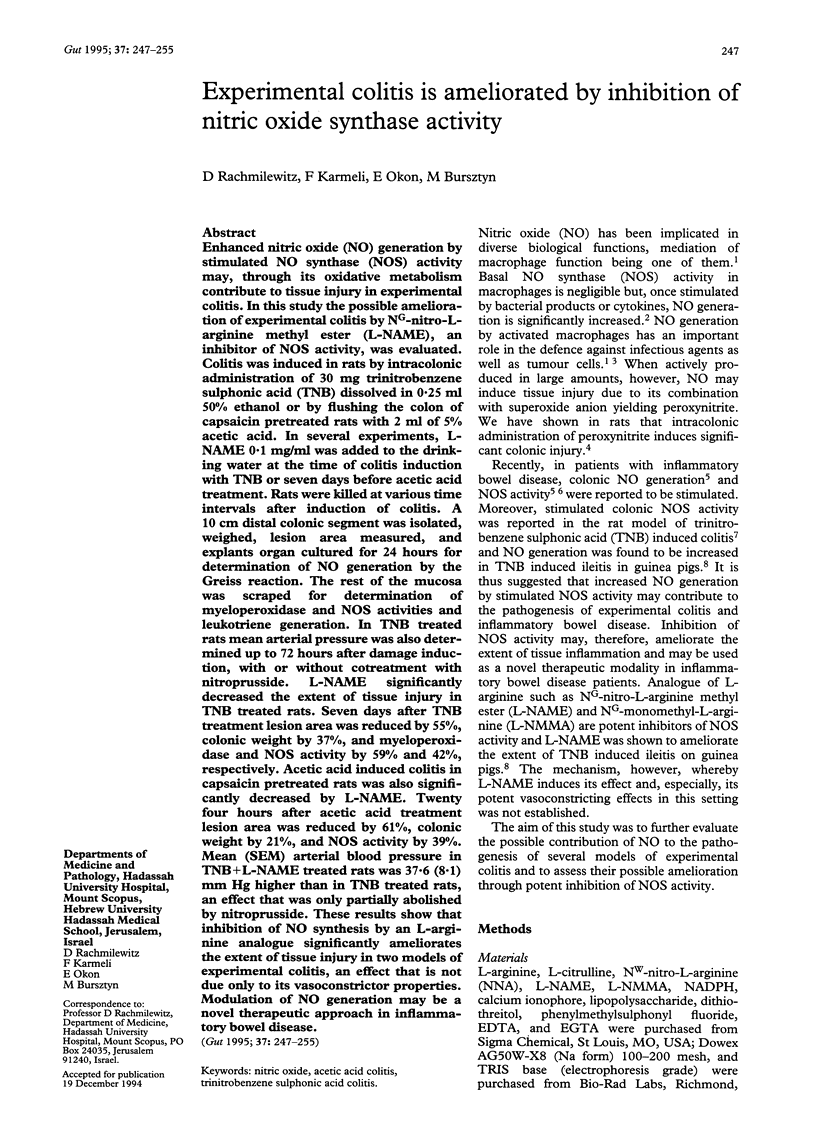

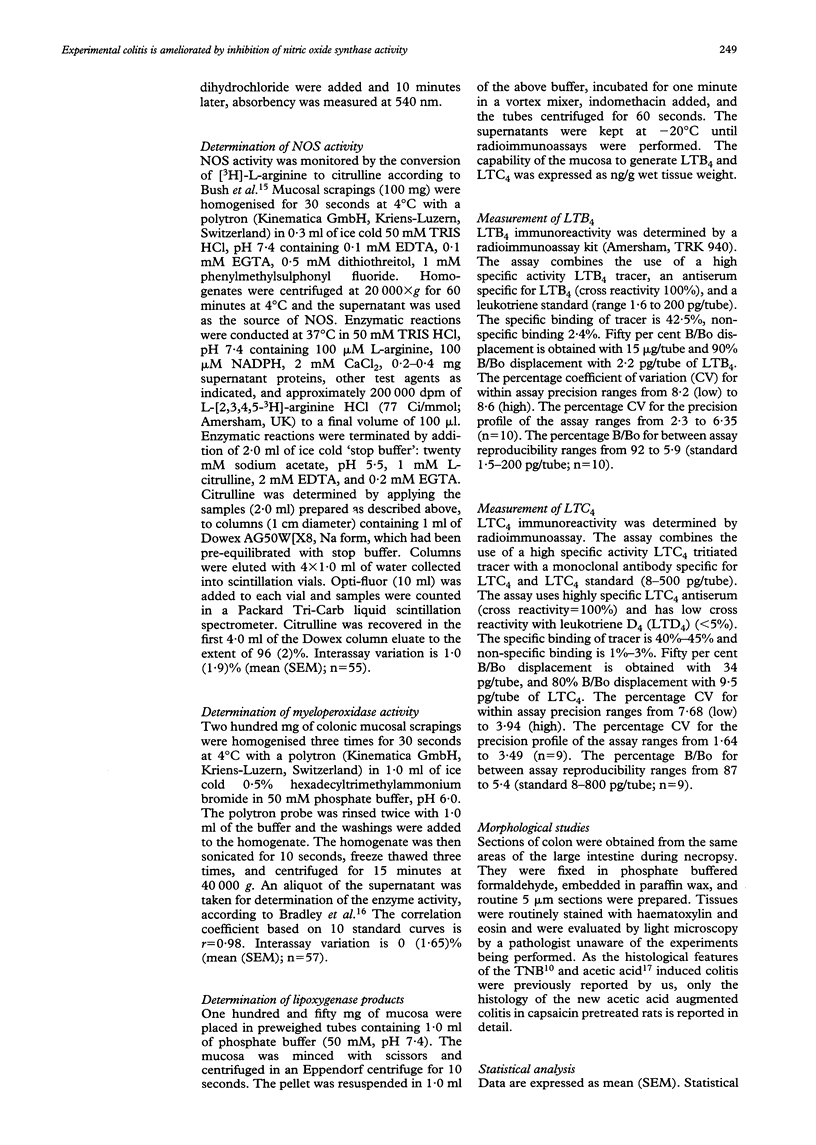

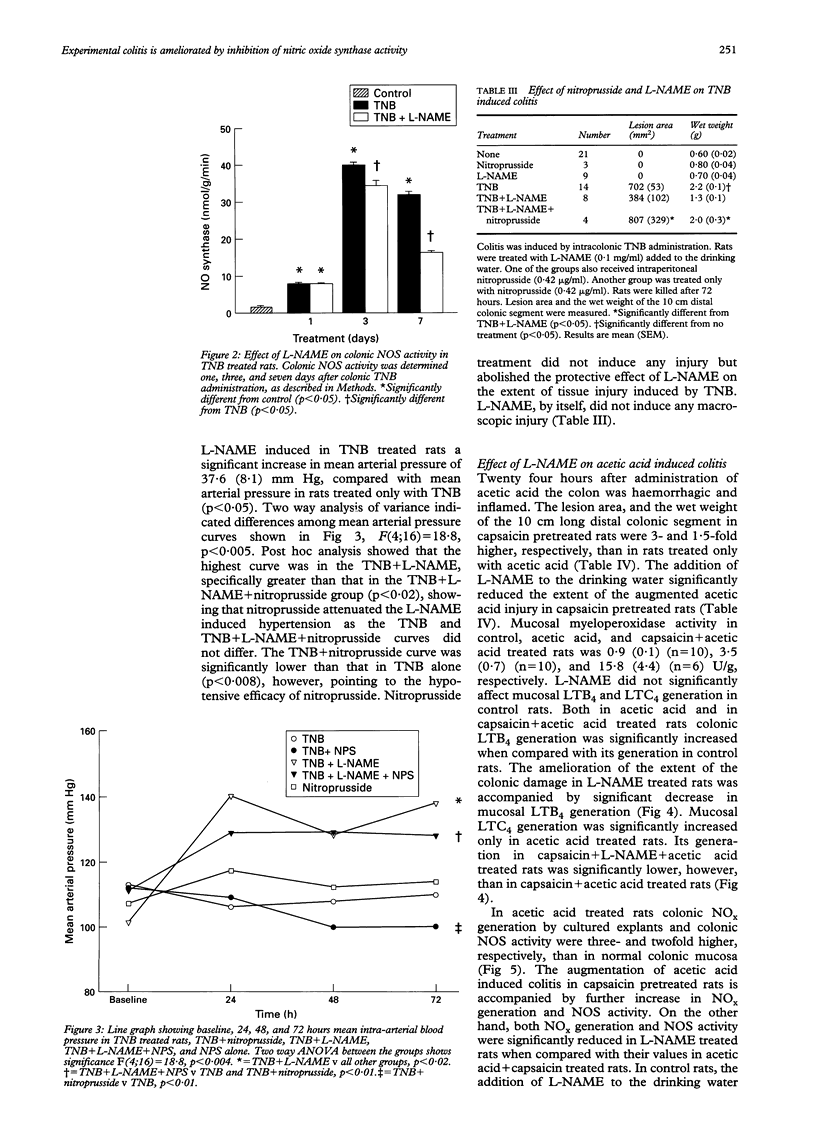
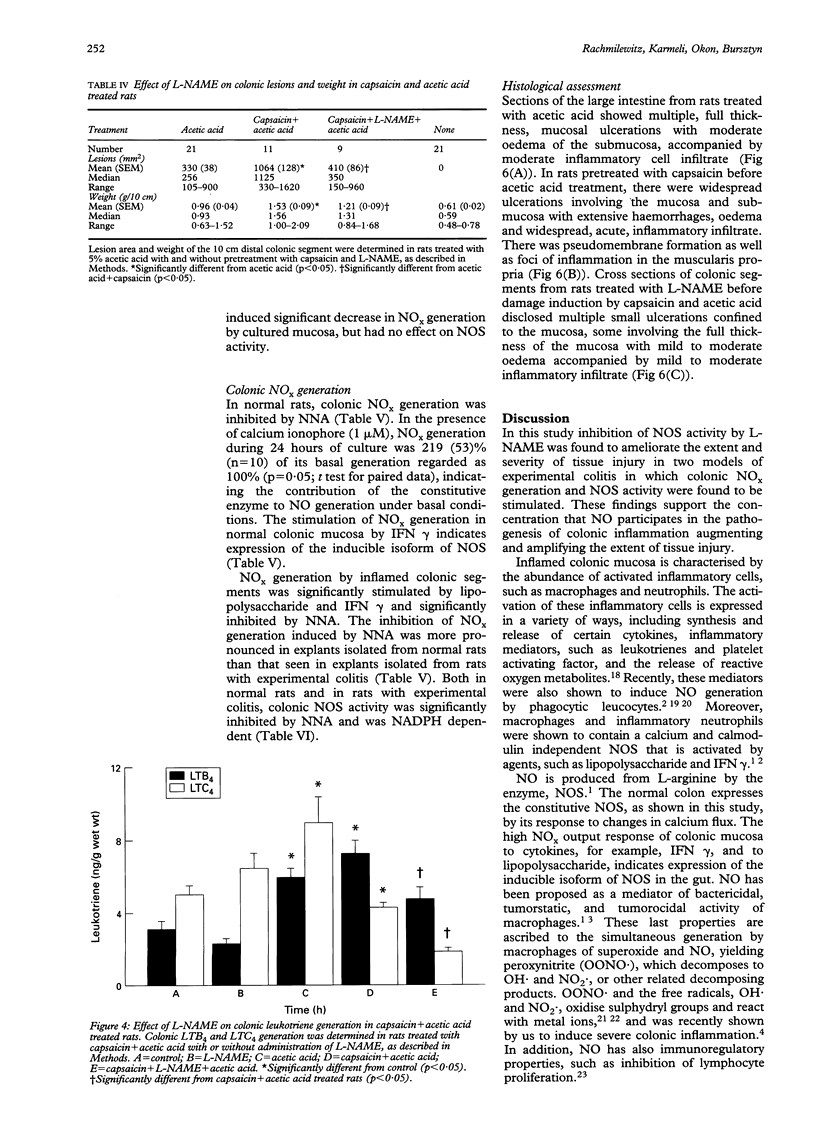
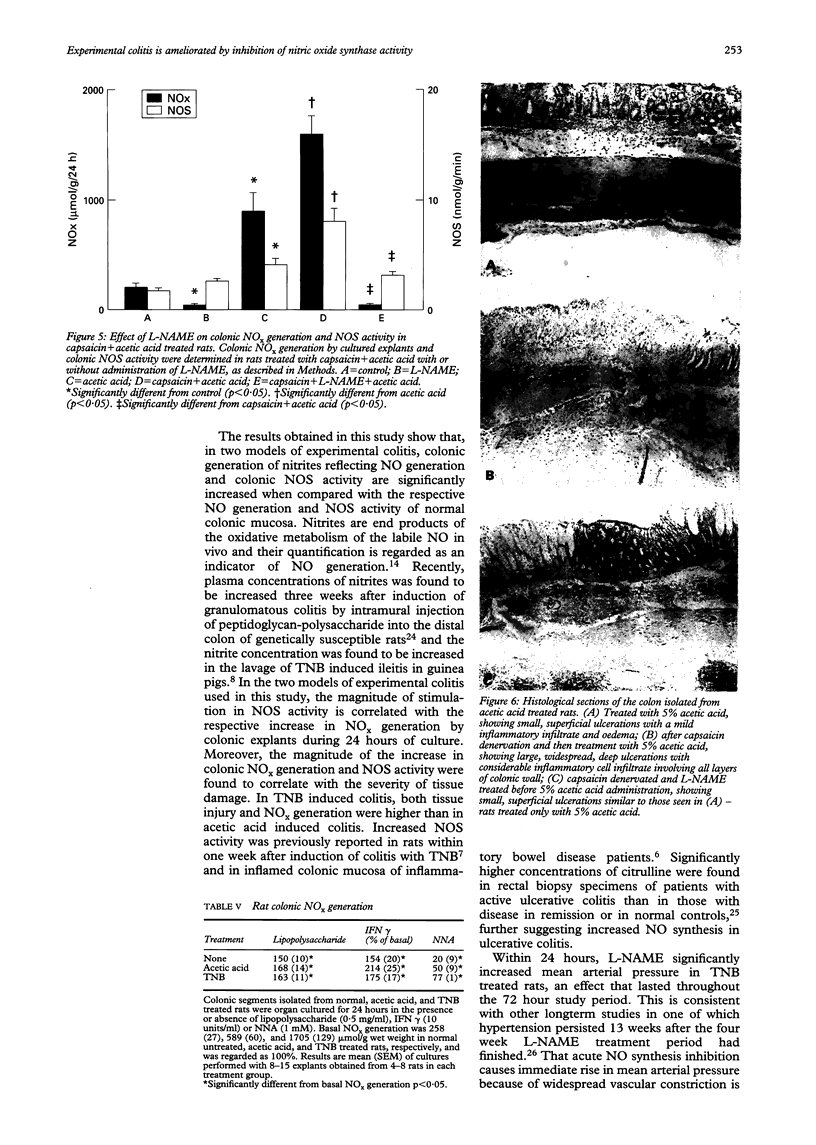


Images in this article
Selected References
These references are in PubMed. This may not be the complete list of references from this article.
- Beckman J. S., Beckman T. W., Chen J., Marshall P. A., Freeman B. A. Apparent hydroxyl radical production by peroxynitrite: implications for endothelial injury from nitric oxide and superoxide. Proc Natl Acad Sci U S A. 1990 Feb;87(4):1620–1624. doi: 10.1073/pnas.87.4.1620. [DOI] [PMC free article] [PubMed] [Google Scholar]
- Boughton-Smith N. K., Evans S. M., Hawkey C. J., Cole A. T., Balsitis M., Whittle B. J., Moncada S. Nitric oxide synthase activity in ulcerative colitis and Crohn's disease. Lancet. 1993 Aug 7;342(8867):338–340. doi: 10.1016/0140-6736(93)91476-3. [DOI] [PubMed] [Google Scholar]
- Boughton-Smith N. K., Hutcheson I. R., Deakin A. M., Whittle B. J., Moncada S. Protective effect of S-nitroso-N-acetyl-penicillamine in endotoxin-induced acute intestinal damage in the rat. Eur J Pharmacol. 1990 Dec 4;191(3):485–488. doi: 10.1016/0014-2999(90)94185-z. [DOI] [PubMed] [Google Scholar]
- Bradley P. P., Priebat D. A., Christensen R. D., Rothstein G. Measurement of cutaneous inflammation: estimation of neutrophil content with an enzyme marker. J Invest Dermatol. 1982 Mar;78(3):206–209. doi: 10.1111/1523-1747.ep12506462. [DOI] [PubMed] [Google Scholar]
- Bush P. A., Gonzalez N. E., Griscavage J. M., Ignarro L. J. Nitric oxide synthase from cerebellum catalyzes the formation of equimolar quantities of nitric oxide and citrulline from L-arginine. Biochem Biophys Res Commun. 1992 Jun 30;185(3):960–966. doi: 10.1016/0006-291x(92)91720-b. [DOI] [PubMed] [Google Scholar]
- Eliakim R., Karmeli F., Okon E., Rachmilewitz D. Ketotifen effectively prevents mucosal damage in experimental colitis. Gut. 1992 Nov;33(11):1498–1503. doi: 10.1136/gut.33.11.1498. [DOI] [PMC free article] [PubMed] [Google Scholar]
- Gardiner S. M., Compton A. M., Bennett T., Palmer R. M., Moncada S. Control of regional blood flow by endothelium-derived nitric oxide. Hypertension. 1990 May;15(5):486–492. doi: 10.1161/01.hyp.15.5.486. [DOI] [PubMed] [Google Scholar]
- Gardiner S. M., Compton A. M., Bennett T., Palmer R. M., Moncada S. Regional haemodynamic changes during oral ingestion of NG-monomethyl-L-arginine or NG-nitro-L-arginine methyl ester in conscious Brattleboro rats. Br J Pharmacol. 1990 Sep;101(1):10–12. doi: 10.1111/j.1476-5381.1990.tb12079.x. [DOI] [PMC free article] [PubMed] [Google Scholar]
- Grisham M. B., Ware K., Gilleland H. E., Jr, Gilleland L. B., Abell C. L., Yamada T. Neutrophil-mediated nitrosamine formation: role of nitric oxide in rats. Gastroenterology. 1992 Oct;103(4):1260–1266. doi: 10.1016/0016-5085(92)91513-4. [DOI] [PubMed] [Google Scholar]
- Hibbs J. B., Jr, Vavrin Z., Taintor R. R. L-arginine is required for expression of the activated macrophage effector mechanism causing selective metabolic inhibition in target cells. J Immunol. 1987 Jan 15;138(2):550–565. [PubMed] [Google Scholar]
- Ignarro L. J. Biosynthesis and metabolism of endothelium-derived nitric oxide. Annu Rev Pharmacol Toxicol. 1990;30:535–560. doi: 10.1146/annurev.pa.30.040190.002535. [DOI] [PubMed] [Google Scholar]
- MacNaughton W. K., Cirino G., Wallace J. L. Endothelium-derived relaxing factor (nitric oxide) has protective actions in the stomach. Life Sci. 1989;45(20):1869–1876. doi: 10.1016/0024-3205(89)90540-7. [DOI] [PubMed] [Google Scholar]
- Martling C. R. Sensory nerves containing tachykinins and CGRP in the lower airways. Functional implications for bronchoconstriction, vasodilatation and protein extravasation. Acta Physiol Scand Suppl. 1987;563:1–57. [PubMed] [Google Scholar]
- Middleton S. J., Shorthouse M., Hunter J. O. Increased nitric oxide synthesis in ulcerative colitis. Lancet. 1993 Feb 20;341(8843):465–466. doi: 10.1016/0140-6736(93)90211-x. [DOI] [PubMed] [Google Scholar]
- Miller M. J., Sadowska-Krowicka H., Chotinaruemol S., Kakkis J. L., Clark D. A. Amelioration of chronic ileitis by nitric oxide synthase inhibition. J Pharmacol Exp Ther. 1993 Jan;264(1):11–16. [PubMed] [Google Scholar]
- Morton J. J., Beattie E. C., Speirs A., Gulliver F. Persistent hypertension following inhibition of nitric oxide formation in the young Wistar rat: role of renin and vascular hypertrophy. J Hypertens. 1993 Oct;11(10):1083–1088. doi: 10.1097/00004872-199310000-00012. [DOI] [PubMed] [Google Scholar]
- Nathan C. Nitric oxide as a secretory product of mammalian cells. FASEB J. 1992 Sep;6(12):3051–3064. [PubMed] [Google Scholar]
- Rachmilewitz D., Simon P. L., Schwartz L. W., Griswold D. E., Fondacaro J. D., Wasserman M. A. Inflammatory mediators of experimental colitis in rats. Gastroenterology. 1989 Aug;97(2):326–337. doi: 10.1016/0016-5085(89)90068-1. [DOI] [PubMed] [Google Scholar]
- Rachmilewitz D., Stamler J. S., Karmeli F., Mullins M. E., Singel D. J., Loscalzo J., Xavier R. J., Podolsky D. K. Peroxynitrite-induced rat colitis--a new model of colonic inflammation. Gastroenterology. 1993 Dec;105(6):1681–1688. doi: 10.1016/0016-5085(93)91063-n. [DOI] [PubMed] [Google Scholar]
- Sharon P., Ligumsky M., Rachmilewitz D., Zor U. Role of prostaglandins in ulcerative colitis. Enhanced production during active disease and inhibition by sulfasalazine. Gastroenterology. 1978 Oct;75(4):638–640. [PubMed] [Google Scholar]
- Skaleric U., Allen J. B., Smith P. D., Mergenhagen S. E., Wahl S. M. Inhibitors of reactive oxygen intermediates suppress bacterial cell wall-induced arthritis. J Immunol. 1991 Oct 15;147(8):2559–2564. [PubMed] [Google Scholar]
- Stuehr D. J., Marletta M. A. Mammalian nitrate biosynthesis: mouse macrophages produce nitrite and nitrate in response to Escherichia coli lipopolysaccharide. Proc Natl Acad Sci U S A. 1985 Nov;82(22):7738–7742. doi: 10.1073/pnas.82.22.7738. [DOI] [PMC free article] [PubMed] [Google Scholar]
- Xie Q. W., Cho H. J., Calaycay J., Mumford R. A., Swiderek K. M., Lee T. D., Ding A., Troso T., Nathan C. Cloning and characterization of inducible nitric oxide synthase from mouse macrophages. Science. 1992 Apr 10;256(5054):225–228. doi: 10.1126/science.1373522. [DOI] [PubMed] [Google Scholar]
- Yamada T., Sartor R. B., Marshall S., Specian R. D., Grisham M. B. Mucosal injury and inflammation in a model of chronic granulomatous colitis in rats. Gastroenterology. 1993 Mar;104(3):759–771. doi: 10.1016/0016-5085(93)91011-6. [DOI] [PubMed] [Google Scholar]
- Zhu L., Gunn C., Beckman J. S. Bactericidal activity of peroxynitrite. Arch Biochem Biophys. 1992 Nov 1;298(2):452–457. doi: 10.1016/0003-9861(92)90434-x. [DOI] [PubMed] [Google Scholar]



